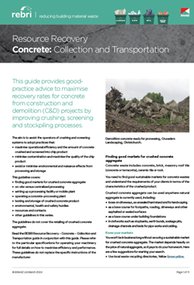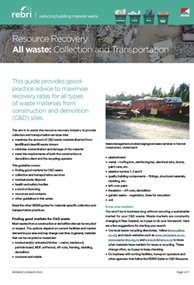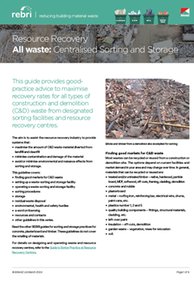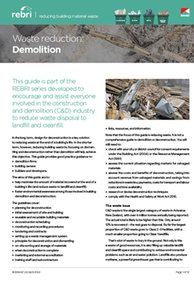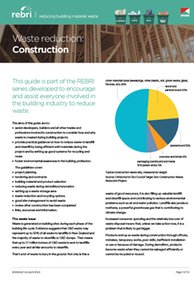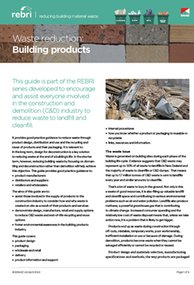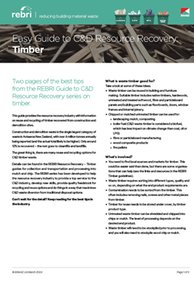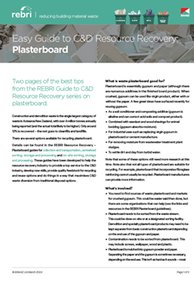REBRI Resource Recovery Concrete: Collection and Transportation (PDF)
This guide provides good practice advice to maximise recovery rates for concrete from construction and demolition (C&D) projects by improving crushing, screening and stockpiling processes.
The aim is to assist the operators of crushing and screening systems to adopt practices that:
- maximise operational efficiency and the amount of concrete crushed and screened into chip product
- minimise contamination and maximise the quality of the chip product
- avoid or minimise environmental and nuisance effects from processing and storage.
This guideline covers:
- finding good markets for waste concrete
- collection and transportation services
- heath and safety hurdles
- resources and contacts
- other guidelines in this series.
REBRI Resource Recovery All waste: Collection and Transportation (PDF)
This guide provides good practice advice to maximise recovery rates for all types of waste materials from construction and demolition (C&D) sites.
The aim is to assist the resource recovery industry to provide collection and transportation services that:
- maximise the amount of C&D waste material diverted from landfill and cleanfill waste stream
- minimise contamination and damage of the material
- meet the requirements of both the construction or demolition client and the recycling operator.
This guideline covers:
- finding good markets for C&D waste
- collection and transportation services
- residual waste disposal
- health and safety hurdles
- a word on licensing
- resources and contacts
- other guidelines in this series.
REBRI Resource Recovery All waste: Centralised Sorting and Storage (PDF)
This guide provides good practice advice to maximise recovery rates for all types of construction and demolition (C&D) waste from designated sorting facilities and resource recovery centres.
The aim is to assist the resource recovery industry to provide systems that:
- maximise the amount of C&D waste material diverted from landfill and cleanfill
- minimise contamination and damage of the material
- avoid or minimise environmental and nuisance effects from sorting and storage.
This guideline covers:
- finding good markets for C&D waste
- setting up a waste-sorting and storage facility
- operating a waste-sorting and storage facility
- sorting procedures
- storage
- residual waste disposal
- environmental, health and safety hurdles
- a word on licensing
- resources and contacts
- other guidelines in this series.
REBRI Waste reduction: Demolition (PDF)
This guide is part of the REBRI series developed to encourage and assist everyone involved in the construction and demolition (C&D) industry to reduce waste disposal to landfill and cleanfill.
In the long term, design for deconstruction is a key solution to reducing waste at the end of a building’s life. In the shorter term, however, reducing building waste by focusing on dismantling and deconstruction rather than demolition will help achieve this objective.
This guide provides good practice guidance to:
- demolition firms
- building owners
- builders and developers.
The aims of this guide are to:
- help maximise the amount of material recovered at the end of a building’s life (and reduce waste to landfill and cleanfill)
- foster environmental awareness among those involved in building demolition and deconstruction.
The guidelines cover:
- planning for deconstruction
- initial assessment of site and building
- reusable and recyclable building materials
- deconstruction scheduling
- monitoring and recording procedures
- tendering and contracts
- setting up a waste minimisation system
- principles for deconstruction and dismantling
- on-site sorting and storage of materials
- when deconstruction is complete
- marketing and external accreditation
- training staff and subcontractors
- links, resources, and information.
REBRI Waste reduction: Construction (PDF)
This guide is part of the REBRI series developed to encourage and assist everyone involved in the building industry to reduce waste.
The aims of this guide are to:
- assist developers, builders and all other trades and professions involved in construction to consider how and why waste is created during building projects
- provide practical guidance on how to reduce waste to landfill and cleanfill by being efficient with materials during the project and by setting up good systems for recycling and reuse
- foster environmental awareness in the building profession.
The guidelines cover:
- project planning
- tendering and contracts
- building material and product selection
- reducing waste during demolition/renovation
- setting up a waste storage area
- waste reduction and recycling options
- good site management to avoid waste
- review after construction has been completed
- links, resources and information.
REBRI Waste reduction: Building products (PDF)
This guide is part of the REBRI series developed to encourage and assist everyone involved in the construction and demolition (C&D) industry to reduce waste to landfill and cleanfill.
It provides good practice guidance to reduce waste through product design, distribution and use and the recycling and reuse of products and their packaging. In the long term, design for deconstruction is a key solution to reducing waste at the end of a building’s life. In the shorter term, however, reducing building waste by focusing on dismantling and deconstruction rather than demolition will help achieve this objective.
This guide provides good practice guidance to:
- product manufacturers
- distributors and suppliers
- retailers and wholesalers.
The aims of this guide are to:
- assist those involved in the supply of products to the construction industry to consider how and why waste is created on site as a result of their products and services
- demonstrate design, manufacture, retail and supply options to reduce C&D waste and end-of-life recycling and reuse options
- foster environmental awareness in the building products industry.
This guide covers:
- product design
- packaging
- wholesale and retail
- delivery
- product information and support
- internal procedures
- how you know whether a product or packaging is reusable or recyclable
- links, resources and information.
REBRI Easy Guide to C&D Resource Recovery: Timber (PDF)
Two pages of the best tips from the REBRI Guide to C&D Resource Recovery series on timber.
Features:
- What is waste timber good for?
- What’s involved?
- Some things to think about
- Examples from those out there doing it
REBRI Easy Guide to C&D Resource Recovery: Plasterboard (PDF)
Two pages of the best tips from the REBRI Guide to C&D Resource Recovery series on plasterboard.
Features:
- What is waste plasterboard good for?
- What’s involved?
- Some things to think about
- Examples from those out there doing it
